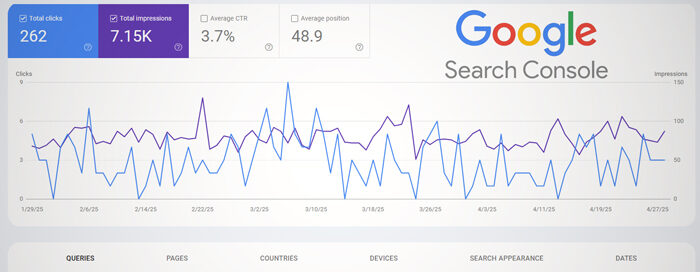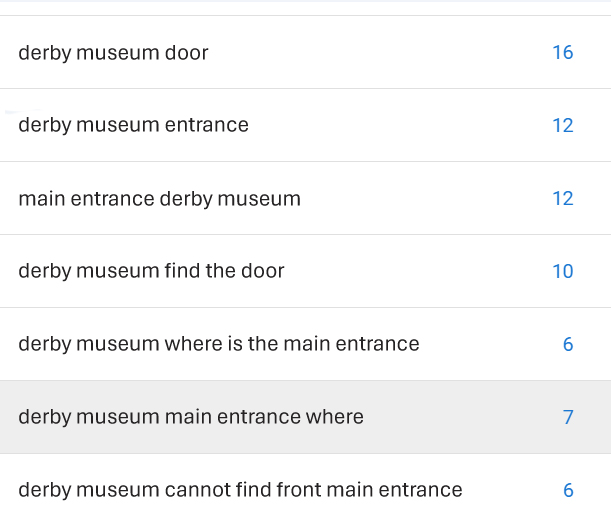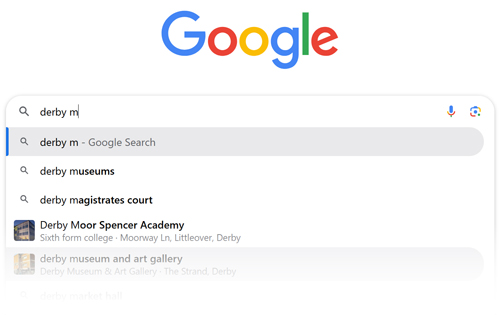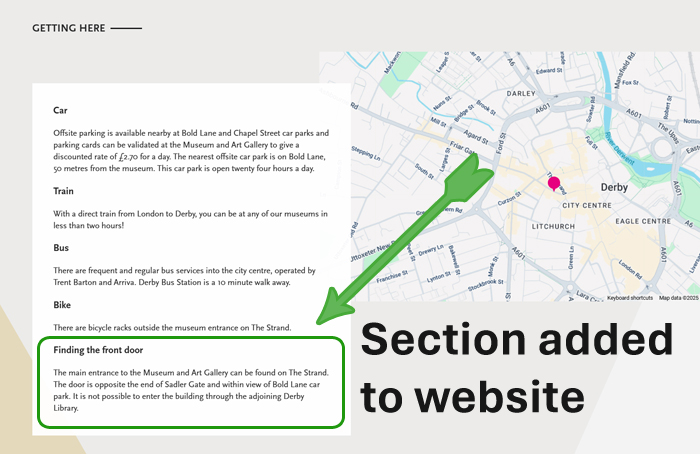You don’t need to be a big-brained boffin to spot vital “data” clues pointing to fixable business issues and golden opportunities.
Video Transcript
Hello, let's talk about how we can improve your business using data – that which you've gathered from analytics tools or actually by having conversations with real people. I'm calling this "Your Website Plus Data Insights Equals Informed Prospects and Happier Buyers".
Yeah, that's a mouthful and it sounds like a mathematical formula!
It's not really. It's actually quite simple and I'll explain as I go through this. It's about creating content that you KNOW people are searching for, and people often need this content but they might not REALISE it until that problem raises its head.
Sometimes, data that you've gleaned, that you've gathered – say, using Bing Webmaster Tools or Google Search Console – can reveal a glaring issue in your business that needs fixing... and I'll give you an example of that.
A few years ago I was at a conference where the speaker – an SEO and UX expert – was talking about how to solve real problems in the real world using data. So, she had been working on the website of a city museum – I think it was Derby Museum, as I recall – this was 2017, 2018 and Google Search Console had been installed on the museum website. I believe it was Search Console – it might have been something else – and it helped her and the people working at the museum to understand how people were finding the website.
And it turns out a surprising number of users were Googling variations on the following phrase: "Derby museum main entrance", "Derby museum entrance", "Derby museum door".
Well they had no problem finding the website, but they were... you know, running into ANOTHER problem which was: they couldn't actually get into the building. It was hard to know where the entrance was. They were trying all these doors and they were locked and they were thinking "how do we get in?"
So the museum, together with the SEO and UX expert, created a new section on the museum website about venue accessibility – how to get into the building – and they were very specific about that, and they knew that by adding this information, that when people Googled the words "Derby museum entrance" or "find the door", that this page would be returning itself as a result, and then answering that question.
Now, some people might just call up the museum and say "How do I get into the building?" and, you know, that's fine. Some people don't like to phone up, or maybe, I don't know, maybe there was a bewildering labyrinth phone system with loads of options and it was just too much hassle – who knows? – but people certainly DO Google things when they've got a problem, and they like to self-serve with the answer.
So, pretty simple. Data revealed a real world problem and content solved it. Business operations benefited from some common sense and you can do the same.
So, install tools like Google Search Console or Bing Webmaster Tools – you could use both. I would actually recommend that you do do that. Setting up Google Search Console is quite easy and then you can look at what you're ranking for – so you have to give it time to gather the data – but, you know, some businesses will be ranking exactly for the words that they're targeting, and everything could be fine, BUT you might have an answer to a question that they have.
So, ask yourself: are people finding what they actually need?
So, THIS business is fine. I've gone through some of the Google Search Console data and I can't see any problems. But, you know, some of the click data may be hidden, so I might have to comb through that and see if I can find something interesting or revealing, but you might need to improve page titles and meta descriptions, you might want to tweak content to better match search intent.
Like, if you've got, you know... the name of your business is similar to another business, maybe there's two different organisations with similar names and people are mistakenly clicking through to your website when they wanted a completely different website... so they're clicking through and then going back to the search results which is known as pogoing which can't be good for ranking – assuming that kind of data is used as a ranking signal – and you might want to create new pages entirely based on what people are looking for.
So, rather than having a section on a web page, you might just want to create a whole new web page out of that.
For example, I had a client a few years ago who had a particular type of insurance, and that was mentioned on some of the pages, but I said, "Listen... let's just create an entire page just about this sort of insurance that you have. That can be a page unto itself."
So, we did that and then he got a lead – and a client subsequently – and when that person was asked "how did you find us – me – the business?" this person said, "I've got a budget to spend on your services but the terms of the agreement I have with somebody stipulate that they must have this type of insurance... you must have THIS type of insurance."
So, someone found their way into my client's website based on the fact that they were querying the name of a particular type of insurance. Interesting, that.
So, data isn't just digital. If you're a business owner involved in day-to-day operations, the chances are you're on the phone... you're wearing all the hats, you know "chief cook and bottle washer"... so, you know, you're on the front line talking to people, and guess what? That's verbal data.
So, start noting the recurring questions that people ask you. It might be that patterns emerge – Lieutenant Columbo knows exactly what I'm talking about. You might be able to identify common concerns – the top three problems that people have – the questions that prospects seem to keep asking over and over again, which would probably benefit and warrant say, a short YouTube video which you could email to them or display on your website by embedding it.
You could create content which kind of frees you up a little bit... you know, make your website a sales team... a 24 hour shop window with all the stuff that people want to see and learn about.
So, use that insight to create these assets and these articles, videos, whatever can address those sticking points, fill in knowledge gaps, build trust, shorten sales cycles. Even if these things don't bring in SEO traffic, they're good for sales enablement. And you can repurpose this content: videos, articles blah blah blah... pin it to the top of your LinkedIn profile LinkedIn page or on your Facebook business page.
I looked in my Google Analytics not long ago and I discovered that the two most popular pages – apart from blogs... certain blogs are ranking quite high – it's the Home page and the Contact page... oh and the About page... but people mostly go for the Contact page because they don't tend to read all the sort of stuff that I've put together... they just go straight to the Contact page, because they want to get a phone number to call me... or send me an email... so they skip the bit that I want them to go through – which is the middle of the funnel – where I want them ideally to consume that stuff.
So, to create a better user journey – and as well as a better educated prospect – I added some expandable accordions on the Contact page with answers to frequently asked questions. So, there you go. So, when people go to the Contact page and they're scrolling up and down looking at my calendar availability, looking at the contact form, looking at an introductory video that I've created, there's these accordions which when clicked will expand, and some of these answers to questions are ones that I haven't actually been asked very often but I know are important, because I need to fill in a knowledge gap, or have someone understand a certain concept, you know... like project management or something like that... account management. So, they can expand these things and then this is internal linking. So, these links go off to other pages on the website.
So, whether the data is in your head or it's in your analytics dashboard, treat it like gold. Find it. Mine it. Use it build content that helps your prospects feel more confident, more informed, ready to buy, closer to the bottom of the funnel.
Your Website Plus Data Insights Equals Informed Prospects and Happier Buyers. It's that simple. Not at all complicated.
Here’s how to improve your website experience using data – data you’ve gathered either from analytics tools or from actual conversations.
Sometimes, the data reveals a glaring issue in your business that needs fixing. Let me give you an example…
A few years ago, I was at a conference where the speaker – an SEO and UX expert – shared a brilliant story. She’d been working with a city museum and installed Google Search Console on their website to see how people were finding them. 📊
The GSC data showed something small but noteworthy.
Take a look at the keyphrases:
Turns out, lots of users Googled variations of “Derby Museum main entrance”.
Hmm.
Not something you’d expect to search for – unless the entrance is ridiculously hard to find. And it was. The front door was actually a weird side entrance, completely unintuitive.
People weren’t finding what they needed, so they Googled the answer. Not uncommon!
They were also phoning the main reception to ask: “where is the main entrance?”
This is a waste of everyone’s time – for both the visitor and the perhaps-slightly-irritated receptionist, who has, undoubtedly, answered this question many times.
And what did the SEO and UX expert suggest?
Yep. You guessed it…
…to add a section on the home page of the museum website labelled “Finding the front door” with directions and relevant keywords.
That’s what they did. Take a look. 👇
Simple. Effective. Data revealed a real-world problem, and content solved it. That’s how data and websites come together to serve real people. 👍
If you ignore your analytics, you’ll miss important stuff happening right under your nose.
A Different Way to Look at “Data”
By the way, data isn’t just digital. It isn’t only locked away in analytics dashboards.
No… data is in your head too. It’s your knowledge, experience, wisdom, mistakes, lessons, conversations and anything else you’ve picked up and filed away in the back of your mind over the years.
Ferret it out. Dig it up. That stuff is GOLD. It’s the bones of your most important website content.
Free Data is Your Bread and Butter
Prospects and customers ask the same questions over and over. There’s a pattern. 📌📌📌
Those questions can form the basis of topics. Each topic should be turned into a bit of content you can rely on. It’s like having assistants outside your shop 24/7, answering questions and explaining the details of whatever you sell.
And for those who know marketing lingo: think bottom and middle of the funnel. 👥
Gather Data and Look for Patterns 📋
The next time you have a conversation with a prospect or client, ask good questions (use the “what do you mean?” technique to really get them talking).
And keep in mind:
- 📈 Logical analytics dashboards show raw, real data
- 📉 Un-logical people (most of us) obfuscate what they mean without realising it
And if you’re one of them slimy commission-breath sales consultants from Yell, people won’t tell you anything because they don’t trust you.
We can boil it down to a simple equation:
Your Website + Data Insights
= Informed Prospects and Happier Buyers
I’m telling, you there’s data to be mined. ⛏️
If, for example, you’re running a Google Ads campaign, you might be ranking for keywords you weren’t even targeting.
This happens when you bid on broad match keywords.
You’d have to be careful since it can burn through your budget – meaning your ad might get clicks for irrelevant keywords.
But some of those keywords are valuable.
And remember: as a Google Ads customer you’re not only paying to show your ads to people based on data they type in – you’re paying for the data itself.
That keyword data can tell you what direction to take your website’s subject matter in.
Use those clues to create the content people are interested in and you might pick up organic traffic when you target those keywords on your webpages.
You would add irrelevant Google Ad keywords to the negative keywords list and focus upon the useful ones your Google ad appeared next to.
Train Hard, Fight Easy: Use Data to Outsmart the Chaos
Solve problems up front using both quantitative and qualitative data. Make it easier for people to succeed in getting what they want and need
Make life easier for your prospects, clients/customers and yourself. Maybe you don’t have the resources to employ salespeople or customer service assistants.
I mean, do you really want to spend all day on the phone chewing the fat with tyre kickers? Perhaps you do. I dunno. 🤷♂️
It’s just that we live in a world of online self service…
…so be clever. ⚙️
Use free and paid-for intel to feed the right info, to the right person, at the right time. They might just buy because of it.




